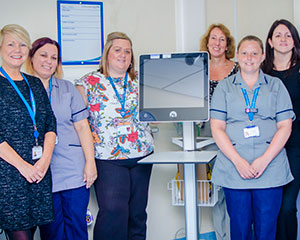A NEW electronic system which will monitor babies’ heart rates during their mother’s labour period has been installed at the maternity units at The Royal Oldham Hospital and North Manchester General Hospital.
Over £300k has been invested in the K2 medical system which provides a fetal monitoring system to support the management of women with high risk pregnancies during their labour, with the ability to digitally archive data.
Electronic fetal heart monitoring is carried out to keep track of the baby’s heart rate and is a good way of telling if the baby is coping well with labour or is encountering some problems which may result in an intervention being made or being delivered by caesarean section.
The monitoring can be carried out externally which involves two sensors which are held in place with elastic belts on the mother’s abdomen. One sensor uses ultrasound to check the baby’s heart rate, whilst the other sensor measures the frequency and length of the mother’s contractions.
Internal fetal monitoring involves a sensor being attached to the mother’s thigh and a thin wire (electrode) from the sensor put through her cervix into her uterus. The electrode is then attached to the baby’s scalp to monitor its heartbeat.
The new equipment purchased for The Royal Oldham Hospital and North Manchester General Hospital maternity service includes a large amount of equipment and a software package, and is part of a wider programme of improving outcomes and safety for women and children.
Previously staff used monitors at the bedside and a paper recording of the heart rate trace, however, the K2 system provides a central monitoring and archiving solution for the fetal heart during labour.
The equipment will improve patient care by having an electronic recording at the bedside, and it can also be used remotely and reviewed by other clinicians, so that advice and support can be given if required.
When using the new equipment the heart rate trace is electronically archived, replacing the need for making paper based notes during labour.
Fourteen computer portals run the programme in each labour unit and this allows better surveillance of the women in labour by the multi-disciplinary team, as all their results can be viewed via a central screen in the ward office.
Extensive training has been provided on the system and there is a K2 dedicated midwife on each site who is responsible for training all staff.
K2 admin midwife at North Manchester General Hospital, Wendy Knight, said: “The new system is a very exciting venture for Pennine. The midwives are looking forward to the introduction of the new technology and we think women in labour will feel reassured that their ‘precious cargo’ has the attention of multiple clinicians.”
K2 admin midwife at The Royal Oldham Hospital Priscilla Poole, said: “We are all very excited about the introduction and future development of this new system. It will help towards improving outcomes due to increased surveillance of the fetal heart rate via the central station, also enabling the multidisciplinary team to view the fetal heart rate remotely. This will provide extra reassurance for women and their families.”
Miss Caroline Rice, consultant in obstetrics and gynaecology and clinical lead for the K2 system, said: “This new fetal heart rate monitoring system will provide our families and staff with additional support during labour. The ability to view the trace on a central screen enables the obstetricians and midwives to review the recording without disturbing the one to one care that the mother is receiving. The archiving facility will help with any review of cases after delivery and is an excellent teaching and training resource. Overall it will increase the safety of the mothers and babies being born in Pennine Acute Trust and we are eager to start using the system.”
Deborah Carter, divisional director for the women and children’s division said: “Misinterpretation of the fetal heart rate trace (CTG) is a common feature in labour care throughout the world. The aim of switching to an e-CTG monitoring and archiving system is to reduce harm by making it easier for staff to interpret CTGs using an approved electronic system. This will lead to appropriate and timely intervention where necessary.”







